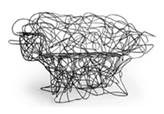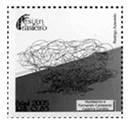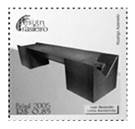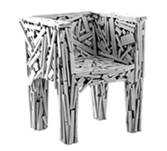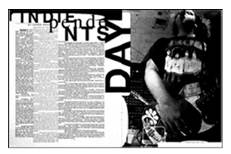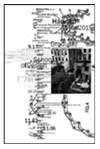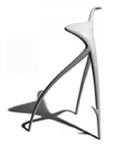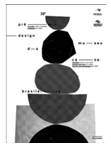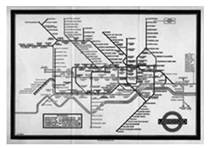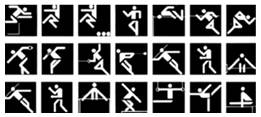The relativistic paradigm which many observe has become prevalent in Western societies seems to imply, at its core, the rejection of objective reality. In this new era of unstable, rotating benchmarks, reality is said to have become rather fluid and dynamic, as in preSocratic philosopher Heraclitus’ view of the now-praised, pervasive notion of an ever-flowing, unstable state of conscience.
Design is a field yet to mature both in terms of being known, and also in its self-knowledge. The concept of design thus loses its basic semantic ballast and landmarks under such relativistic influences, being rather artificially released from its ontological and epistemological distinguishing identity. Design then becomes anything and everything. It may currently be perceived, for instance, as intermingled and sharing its identity with other disciplines, such as fine arts, architecture, engineering, information technology, marketing, advertising, handcrafts, the culinary arts, hair styling, and so on.
This state of affairs seems to promote a distorted, unstable, and diluted cultural substrate, one in which anything seems to be equally valued and accepted. In this context permeated with relativism, there is no objective content to be learned, no extenuating, disciplined work to be accomplished to perfect one’s talent, as the view that everyone is already a designer is disseminated. In this new, more permissive light, no methodological approach in the process of design is perceived to be any better than any other, for the design thought process is depicted as being, after all, intuitive, artistic, free of realworld constraints, and “creative” (as a means of expressing one’s essentially subjective fantasy).
Formerly praised notions with vertical distinctions of merit and demerit, deemed, until recent decades, essential tools in the search for excellence in civilization, are now regarded as démodé and no longer applicable. The so-called “contemporaneity” arguably asks, then, for new forms of perceiving and evaluating reality. In this purportedly fluid environment, the very notion of critique -itself previously valued as a compass guiding the process of perfecting the real, concrete dimension of experience towards its ideal, conceptual counterpart- loses its raison d’être and practical applicability within the new frame of reference. In this new scenario, intrinsic merit would no longer exist, but supposedly only contextual merit of a relational nature. If everything loses its ontological charge in favor of context-based evaluations, it would then no longer make sense to assess critically any individual object, action, or concept, as it will always be possible to come up with a new context in which any given thing negatively or positively perceived in a more objective light may now, under the light of some unusual and highly specific context, be validated and legitimized as being, conversely, positive or negative.
This allegedly installed state of cultural permissiveness and lassitude seemingly promotes the currently witnessed progressive erosion of conceptual boundaries, a phenomenon which has been, however, welcome by many relativistic-minded observers as an auspicious evolution which implies rising entropy levels associated with the reportedly out-dated, narrowly restrained, dogmatically fixed and stable, clear-cut demarcation of ideas and concepts.
In such a vertigo-inducing environment, the field of design, apparently more vulnerable to the indeed strong winds of relativistic external trends, due to its particularly recent inception, becomes even more affected by this “terminological Babel”. In reality, design becomes notorious for its conception fluctuations and exuberant proliferation of new terms and new shades of meaning artfully crafted in order to shift the original meaning of the old, established concepts, which had been, until recently, considered useful, stable, and universally shared.
These more contemporary developments promote not only the necessary conditions for lowering design culture repertoire with an influx of “neo-designers”, but also promote a propitious environment for the proliferation of cliques and territorial feuds within the greater field of design, which are then avidly secured and profitably exploited by their proponents, shielded by fanciful, “hybridized”, new and exquisitely coined expressions.
Within this state of mental shuffling and of terminological labyrinths, design’s cultural repertoire undergoes progressive dilution and consequent decay, causing both its pedagogy and professional standards of practice to likewise decline. Previously valued notions, such as quality, excellence, competence, talent, hard work, and intrinsic merit are now rejected in favor of the new, relativistic, strictly horizontal paradigmatic worldview.
The category of “neo-specialists” in design (who immigrated into the now highly popular, career-breeding, and dramatically expanding field of design coming from neighboring disciplines like the visual arts, illustration, architecture, engineering, information technology, marketing, advertising, handcrafts, and so forth), whose presence has multiplied since the 1990s, eagerly rises to positions of great visibility and political influence in the professional, pedagogical, and academic arena of design, putting forth design exhibitions, publishing books, organizing conferences and meetings, writing articles in high-visibility journals, and heading design undergraduate and graduate programs. Little by little, “neo-designers” become more and more confident to talk and lecture and publish and decide about design’s conceptual identity, as if they were actually knowledgeable of design’s intrinsic attributes. In order to retain and secure their influence in the design field, these “neo-specialists” are tempted to shield themselves in design subdomains by generating this Babel of confusing terms, therefore eroding conceptual categories. They would accomplish this objective by fabricating intricate-but-poetic language, pleonasms and tautologies, which would have previously been unthinkable and meaningless (such as “information design”, “interface design”, “interaction design”, “user-centered design”, “user-experience design”, “user-interface design”, “communication design”, “experimental design”, “authorial design”, “handicrafts design”, “modern design”, “contemporary design”, “emotional design”, “meta-design”, “sustainable design”, “design systems”, and “design thinking”, amongst dozens of other catchy, highly popular, mesmerizing terms that call for new books, new professional associations, new conferences, new journals, etc.), thereby subdividing into restricted, exclusive lots the actual organic and indivisible concept of design, previously praised for its integral nature and character.
Such a terminological Babel which has, arguably, been installed in the field of design, relying on dynamic and seductive wording and newly coined benchmarks, leads to the gradual mental dispersion of the actual -and invaluable- conceptual canons of the design field, which so far have allowed for understanding and objective, effective communication. One dilutes, by means of this ongoing conceptual shuffling, the theoretical landmarks that previously conveyed meaning and that formed the characteristic essence of the design discipline, with its own, specific identity as a stable, recognizable, teachable and profession-ally viable practice, originally created for the ultimate purpose of benefiting society with functional, utilitarian, serviceable, and practical objects, products, graphics and displays. In what seems to be an inevitable decline brought about by the relativistic paroxysm identified within the current historical period of “contemporaneity”, one reaches a state of affairs of fluctuation of concepts and benchmarks similar to George Orwell’s dystopian vision in Nineteen Eighty-Four, in which the practice of newspeak and that of doublethink led to likewise transient, unstable, mutant, evershifting concepts, therefore causing the loss of actual meaning in verbal expression. If the concepts of actual things do shift, reality perceived within this frame of reference becomes itself unstable as well.
Within this scenario of intellectual disorientation, the message of Confucius (551-479 BC) stressed in his Analects, of the need for the “rectification of names” emerges as a very modern, timely, and therapeutic recommendation. Confucius deemed it essential to call each conceptual entity by its own, exact, and identity-capturing name, as a means to promote the flourishing of activities, affairs, and ultimately of society. For him, if conceptual entities were to be imprecisely and loosely employed, they would then become devoid of their semantic value and, ultimately, of their usefulness. This would then lead, according to Confucius, to the inevitable decay of professional crafts, fields and businesses -and, as a consequence, civilization would itself also go astray.
Confucius trusted that the educated individual would seek to express himself with great rigor, accuracy and precision, taking pain to preserve the proper meaning of each concept and term. For him,
A superior man, in regard to what he does not know, shows a cautious reserve. If names be not correct, language is not in accordance with the truth of things. If language be not in accordance with the truth of things, affairs cannot be carried on to success. When affairs cannot be carried on to success, proprieties and music do not flourish. When proprieties and music do not flourish, punishments will not be properly awarded. When punishments are not properly awarded, the people do not know how to move hand or foot. Therefore a superior man considers it necessary that the names he uses may be spoken appropriately, and also that what he speaks may be carried out appropriately. What the superior man requires is just that in his words there may be nothing incorrect1.
As one reads of Confucius’ concern with proper naming of conceptual entities, one may rightfully consider whether any of those fancy expressions that keep coming out to baptize new subdomains will both justify and give rise to a new plethora of cliques (that will exert their quite visible influence and leading role, as already suggested, in design conferences, associations, journals, museum exhibitions, and design education programs -therefore generating, in this regard, a quite impressive and all-encompassing internal coherence in the field of design) and will make any sense at all. It is indeed questionable whether there could ever exist any form of design which does not necessarily include, as a core, distinguishing, indivisible and inalienable component: information, interface, interaction, user-centeredness, user experience, user interface, communication, sustainability, systemic approaches, as well as design’s own conceptual and methodological models.
Just as there is no possible, intelligent meaning in such a thing as a “therapeutic medicine” (as all medicine is inevitably therapeutic, and so “therapeutic medicine” is nonsensical), there is no “interface design”, “interactive design”, “user-centered design”, “design systems”, and so forth. This seems to be so, for design, as suggested above, in its very nature and per definition, inescapably implies information, interface, interaction, user-centeredness, systemic approaches, and so on.
Creating expressions like “information design”, “interface design”, “interaction design”, or “design systems” implies that such attributes are monopolies of these specific subdomains and that all the remaining territory of design does not deal with “information”, “interface”, “interaction”, nor with “systemic approaches”. It further implies that in order to deal with true “information”, “interface”, “interaction”, and “systemic approaches” within the discipline of design, one must look elsewhere for it in the domain of “information design”, “interface design”, “interaction design”, or “design systems”. If one were to create a new domain in medicine, such as “therapeutic medicine” or “healing medicine” (a liberty that would not be at all accepted in this more mature and consolidated field), this would likewise imply that the rest of medicine, outside the newly proposed feuds of “therapeutic medicine” or “healing medicine”, is not therapeutic, nor healing.
The impulse to fabricate such pleonasms and tautologies may then be explained as a form of artificially generating boundaries for one’s affiliates’ own benefit and profit. Notice, however, that at the same time, one erases, as convenient, those natural, conceptual boundaries between the field of design and fields of other domains (therefore allowing newcomers uncritical and unrestricted access to the greater design field), such as that of the fine arts, architecture, engineering, information technology, handcrafts, marketing, and advertising.
This strategy -intuitive and unplanned, as it most certainly seems to be- may then allow for the emergence of cliques and feuds within the greater field of design by promoting the erasing of natural boundaries between the field of design and other fields with very distinct epistemological, ontological, and methodological bodies of knowledge (thereby, artificially erasing design’s external, inbound entropy levels). This tendency, on the other hand, also attempts to build internal walls within the greater field of design (thus, quite symmetrically, lowering also artificially its internal entropy levels). This allows the entrance of “neo-specialists in design” who then become authorities within their newly built artificial areas of exclusive, self-appointed expertise.
Therefore, “neo-designers” manage to get access to the field of design, but are not eager to allow outsiders into their newly-fabricated and terminology-protected feuds. They rarefy “intertextual” boundaries (that is, between the field of design and the neighboring fields), so that they themselves can gain entry into the design field, because, at the “intertextual” level, boundaries would serve as impediments. Then “neo-designers” erect “intratextual” boundaries (isolating for themselves some supposedly new territory of expertise -somewhat similarly to the opportunists in the tale of The Emperor’s New Clothes- within the greater field of design), thus impeding the entry of others -even the entry of actual designers- in their now exclusive domains, as they entrench themselves by means of terminological barriers.
This trend of subdividing, at the “intramolecular level”, the field of design into feuds is aligned with the characteristic dynamics of the greater ideological program of relativism, regarded by many as prevalent in the past decades in Western societies. In fact, relativism’s inherent tendency to multiply “gravitational centers” allows for the coexistence of multiple mutually diverse, even antagonistic worldviews, as being all equally valid. It thus rejects the notion that there could possibly exist an external way of ascertaining, at a macroscopic and allencompassing level, by means of objective and universally legitimate parameters, the intrinsic internal greater or lesser merit of any of these bubbles. In this manner, the relativistic frame of mind leads to the legitimization of such bubbles, and to the resulting fragmentation and multiplication of “realities”, “truths”, and “gravitational suns”. This resonates in the specificity of the field of design, among other aspects, in the currently witnessed proliferation of internal feuds.
At the “intermolecular”, external level, however, relativism works to dilute the boundaries outside conceptual entities -such as the field of design- merrily inviting blends, fusions, hybridizations, combinations, overlaps, fringes, and mixtures. These manifestations are welcomed, as if the sight of the clearcut outline of conceptual entities were symbols of a retrograde mindset. (This rather lax and boundary-averse conception is significantly more intense when specifically originating from within more protected fields and being directed towards less protected ones, such as that of the yet-to-be-consolidated field of design, which are understandably less apt to critically assimilate such an overwhelming inculcating influx.) The relativistic drift, it seems, then has reverberated within the field of design as well. As a consequence, the concept of design has gradually lost, in the past decades, its precise integral outline and identity. For relativism, as remarked, induces that type of “intermolecular” blending, while promoting segregation at the intramolecular level. This points out to the asymmetrical, paradoxical and unstable character of relativism as also manifested in the field of design, as relativism seems eager at once to open up and to make things flexible at the outer, intertextual level, and to close down, making things hard at the inner, intratextual one.
In this manner, together with its loss of external conceptual integrity, design has also been subjected to internal fragmentation into feuds. These subdomains within the field of design then behave as the now so-called “safe spaces”, acting as “echo chambers”, as if they were not a feud, but fields in and of themselves. Within such newly created feuds, those already persuaded of a given ideology will be further reinforced in their views by like-minded peers -in a synergistic process which, ultimately, may lead to a certain degree of hysteria and paroxysm. This is so, for “safe spaces”, acting like “echo chambers”, bring about a highly coherent, and therefore eloquent micro-environment, which, working as a bubble, tends to isolate its members from the outside world, providing them with the utter conviction that their bubble’s internal values and visions are “correct” and do represent the actual outside reality.
The strategy of artificially fabricating internal distinctions within the design field while at the same time attempting to eliminate the natural external distinctions between the field of design and its neighboring fields can only be attributed to a political agenda (even if only at the individual level) to allow newcomers, those neo-specialists in design, who immigrate from neighboring fields, to find an open, however exclusive, entrance to the highly attractive field of design (either in teaching, publishing, and/or working professionally). Personal interests seem to be at the root of such an effort to erase external boundaries which would otherwise prevent these outsiders from enjoying the status of true design authorities and the status of qualified, highly-trained, talented individuals within the design activity.
On the other hand, while fabricating exquisite, catchy, newly-coined expressions and conceptual shades to designate former universally-shared notions and ideas within the field of design, “neo-designers” create internal boundaries for their own benefit. They allow themselves access to the field of design in this process of conceptually blurring external conceptual boundaries between the design field and its neighboring domains, while securing feuds and terminological trenches within the field of design. As a strategy, it makes perfect sense, if one mainly considers one’s own benefits, profits, and personal interests.
This practice is not essentially different from the intuitive and atavist impulse of a colonist, who seeks survival by finding his way into a system, while blocking other people’s posterior access into the very territory which the colonist has managed to secure for himself. The whole objective is to open access inwards (by erasing natural boundaries outside the field) and then close access to other newcomers (by building artificial boundaries around their feuds, which already are inside the greater design field).
In other terms, it becomes necessary for “neo-designers” -this category of individuals which displayed expressive growth rates from the 1990s on, as the field of design became extremely popular and fashionable, both academically and professionally- to efficiently and eloquently erode the external, inward barriers to their own legitimacy as “true designers”, despite the fact that their lifelong original background is almost entirely associated with neighboring fields with a quite distinct epistemological, ontological, aesthetic, as well as methodological body of knowledge. With this wedge of penetration, these individuals also come to enjoy the status of designers, and have free access to the field of design.
Once “neo-designers” manage, however, in this “blurring mode”, to step into the territory of design, their next move is often to build a mesmerizing terminological subdomain to protect themselves from intruders. (For this, they count on other people’s ignorance of theoretical benchmarks and lack of proactive initiative and critical thinking, much like the passive attitude of the onlookers in the tale of The Emperor’s New Clothes).
At this point, in the “protective mode”, newly-conceived conceptual boundaries then become necessary and valuable. As a result, one witnesses the above-mentioned multiplication of an impressive array of freshly-forged expressions to identify supposedly existing new areas of specialization within the greater design field. But how is it that boundaries may no longer be respected at a given moment, as they represent external barriers that characterize the identity of the greater design field itself, whereas, in the next moment, they may be considered legitimate and valuable, when it comes to building artificial walls within the field of design?
Certainly not every “neo-designer” disembarking with arms and baggage in the field of design is focused on building trenches to shield themselves. Neither is it true that all newly-built terminological subdomains are created solely by “neo-designers”. To the contrary, it seems that many “neo-designers” do not engage at all in dambuilding to protect them-selves. In addition, many of these subdomains are also erected by “native” designers.
Nevertheless, the noticeable correlation between recently-installed “neo-designers” and the active imaginative production of new terminological bunkers seems very frequent. This positive correlation may even be justified by “neo-designers” natural sense of insecurity in the relatively threatening new territory of design, thus leading to their also understandable impulse to find convincing means and arguments to differentiate their own profile, in this quest to add value to their possible personal professional contribution in the new, less secure, yet-to-be-conquered, less inviting environment.
One must also note, at this point, that the critique of this apparently pervasive trend in design in the past decades is absent of any xenophobic concern about building walls around the field of design, one which is indeed multidisciplinary by nature, and must continue to be so. The rehabilitation of Confucius’ message in contemporary design scene is intended exclusively to re-establish basic distinctions of merit and demerit, and to restore design’s own epistemological identity in accordance with its internal culture, its mission, conceptual nature and vocation, which have been, until recently, useful in allowing the specific design epistemology to flourish.
Such a critique of the current state of affairs, resorting to Confucius’ call for a “rectification of names”, also implies the need for public scrutiny of these terminological trenches created by “neo-designers” to shield and protect them from even newer newcomers, as the “neo-designers” take action to artificially differentiate their incipient feuds from the larger field of design to which they recently managed to gain access.
The contradiction then becomes even more apparent. In an amusing, ingenuous logical fallacy, “neo-designers” quasiinstinctive endeavor to build walls around a supposedly existing subset (such as “information design”, “interface design”, “interaction design”, “emotional design”, “sustainable design”, “design systems”, and “design thinking”) within the greater field of design, by suggesting that such a subset does not exactly belong to the field of design, as they look forward to differentiating their new territories from the greater design field. In this contradictory logic, such feuds within the greater field of design are supposed to be a subset of the greater field of design, but at the same time, are not contained within the greater field. The feud they have cordoned off is a subset of the greater field of design. However, not every element of such an unusual subset (these terminological subdomains) belongs to the greater set (the larger design discipline), which allegedly contains the subset (as these “specialists” insinuate that what they do is not already an intrinsic part of design). There-fore, such feuds are simultaneously placed both inside and outside the field of design. In a classical conceptual contradiction, these are logical constructs which are at once true and false. They are considered to be both inside and outside the design field, as they “need” to belong to the greater field of design (for these “neo-designers” aim to establish themselves inside the field of design). But, once the “neo-designers” manage to fix their place in the design field (being hired as design professors and/or as design professionals), they often try to make sure that the design field does not contain their specific feuds or subdomains (like “interface design”, which suggests that all other design does not deal, as a central, indivisible component, with the core concept of “interface”).
This seems to be so, for if their newly-established feuds were not separate from the greater field of design, these “neo-designers” would not be capable of differentiating themselves from other designers, failing therefore to actually show any “leverage power” over “regular designers”. In this manner, these feuds (such as “interface design”, “interaction design” and “information design”) belong to a greater set (that of the design field) whose subsets (such as “interface design”, “interaction design” and “information design”) do not belong to the greater set that contains them, therefore resembling G. E. Moore’s wellknown logical paradox.
According to this view, then, “neo-designers’” primary concern is commonly that of shifting the actual meaning of design by creating a state of “conceptual permissiveness” which would also credit and qualify them as actual designers. In this entrance process, they display such a tendency of making tabula rasa of the boundaries around the design field itself, while tearing down design’s natural conceptual boundaries of an epistemological, ontological, aesthetic, and methodological nature.
If they do end up being caught as unqualified non-design intruders, as not actual design authorities, they will promptly resort to the immobilizing, impressive and quite intimidating password: “Multidisciplinarity!” The reference to the sacred, unquestionable multidisciplinary nature of the design domain will immediately prevent any vigilant mind from taking corrective, critical-thinking-based action against this process of blurring otherwise natural conceptual boundaries.
Once “neo-designers” succeed in being accepted into the design club, as suggested above, some of them may very well opt to erect those artificially-crafted terminological barriers to secure their special feuds, so as to mark and save their new territory as their actual property. Instead of the field of design, they therefore promote their own feuds by means of pleonastic, catchy word domains such as the above-mentioned “interface design”, “interaction design”, “information design”, and so on.
As observed, more mature and respected fields, like medicine and architecture, would not admit the intrusion of nonsensical, catchy expressions to designate feuds for neospecialist colonists, such as “therapeutic medicine” or “space-planning architecture”, no matter how enticing these meaningless, but fanciful and poetic expressions might sound (as these new feuds promote individuals’ reputations and generate some public interest).
The “Corallo Chair” (See Figure 1), created by the much-celebrated Brazilian designers Campana Brothers in 2004 for Edra, part of the New York Museum of Modern Art collection, puzzles observers in terms of its design-specific qualities. Notice the indisputable ergonomic, functional, practical, and manufacturing inadequacy of this “chair”, whose conception clearly draws its aesthetic quest from fine arts, here again imposed upon the concept of design.
This not-meant-for-sitting chair sacrifices its intrinsic design qualities, as it clearly defies most basic, long-established design-specific imperatives, such as ergonomic quality, functionality, ease of maintenance, durability, and so on. The “Corallo Chair” seems to derive its essentially visual appeal from the aesthetic and poetics intrinsic to fine arts. Thus this seems to be an eloquent example of the process of shifting the actual concept of product design, in order for it to display an identity different from its actual identity (Estudio Campana). The same “Corallo Chair” featured in a series of four Brazilian Post Office stamps paying tribute (See Figure 2), in 2005, to some of the countries’ most prestigious designers. Notice that the Campana Brothers, who designed this now famous Corallo Chair, were presented as role models of distinguished furniture designers, not of fine artists (Brazilian Post Office). Figure 3 is another example of the 2005 stamp series dedicated to elevating and commending Brazilian design. The wooden bench featured above, part of “Linha Bandeirola”, was created by Ivan Rezende. One can identify the incursion of components from architecture, the fine arts and masonry handcrafts, causing the product to fall short in terms of adequately addressing its ergonomic, functional, and design-specific aesthetic components, aspects which were previously regarded as integral to the very notion of design (Brazilian Post Office).
The “Favela Chair” was also designed by internationally acclaimed Brazilian “designers” Campana Brothers (See Figure 4). This is another example of design products which borrow their aesthetic and poetic components from the fine arts medium of expression, which is then imposed on the design process, altering its results in a way that causes some of its key, essential qualities, such as ergonomics, functionality, practicality, ease of production and maintenance, to be less adequately addressed and integrated into the actual product. The “Favela Chair” was then conceived as a design product which pays little attention to the actual, specific and idiosyncratic nature and meaning of design (Estudio Campana). “Multidão Chair” (“Multitude Chair”. See Figure 5) designed by the Campana Brothers in 2002 is made out of cloth dolls, representing human figures. Here, again, design-specific attributes have been overlooked in favor of fine-arts sculptural and conceptual qualities, causing the chair not to be technically a chair, although it is still called and considered such (Estudio Campana).
Figure 6 is an example of “design work” by Droog Design, in Amsterdam, Netherlands, with clear “contamination” of poetic influxes from fine arts, which has often been welcomed by many art and design critics, despite the fact that such “design products” by Droog Design often fall short in fulfilling a variety of design-specific criteria, such as systemic unity, formal coherence, syntactic adequacy, modulation, lack of arbitrary choices, functionality, and so forth (Wikipedia).Three examples of David Carson’s graphic design work (See Figure 7, 8 and 9), acclaimed but controversial, also drawing influences from the poetics intrinsic to the fine arts domain, with evident conflicts with design-specific constraints, such as ergonomic (including poor information clarity, hierarchy, legibility and intelligibility), functional, linguistic and aesthetic aspects specific to the concept of graphic design (Ray Gun Magazine, Bangkok International Type Symposium 2014, and Harvard Graduate School of Design Fall 2015 catalogue). Two iconic products by French designer and architect Philippe Starck, namely, Stool 884a for Vitra, developed in 1991, and his famous lemon squeezer (“not meant to squeeze”), for Alessi, in 1990 (See Figure 10 and 11). Here, again, the concept of product design is being evoked with little correspondence to the actual concept of product design, which has called, per definition, for an aesthetic specific to the nature of product design, with long-established, indivisible concerns such as ergonomics, functionality, practicality, and safety (Pamono/Vitra and Eataly/Alessi). Great first-prize winner of the highly competitive poster contest for the 2015 Design Award of the Brazilian House Museum, in São Paulo (See Figure 12), with linguistic elements characteristically borrowed from the fine arts aesthetic, which were then imposed onto the graphic design of the poster’s own poetics, creating an ambiguous and allegedly “intriguing” graphic design, patently devoid of clarity, objectivity, information hierarchy, legibility, and intelligibility, qualities which had been indissolubly associated with the activity of design (Brazilian House Museum).
As a counterpoint to the current state of affairs in contemporaneity in the field of design, one may go back to old design canons, much as in the Renaissance when civilization had to rely on ancient canons of excellence, aesthetic pursuit, and sense of purpose. One will promptly realize the significant contrast between the two conceptual models, if one considers the examples analyzed above against the background of major design landmarks, such as Harry Beck’s London Underground map in the thirties, the paramount visual communication system headed by Otl Aicher for the 1972 Munich Olympics, the extremely sophisticated system of stacking dishes designed by Hans Roericht as his final thesis at the HfG Ulm in 1959, and the always-praised design of Braun SK4 radio and record player by Dieter Rams and Hans Gugelot in 1956.
In Harry Beck’s London Underground map designed in 1933 (See Figure 13), clarity, legibility, intelligibility and overall ease of use were primary concerns, in strict alignment with the essence of the graphic design concept (Wikipedia/London Underground).
Otl Aicher’s epic graphic design system for the 1972 Munich Olympics (See Figure 14), part of which is the pictograms displayed above, is still considered to be an as yet unrivaled paradigm of clarity, objectivity, modularity, systemic and systematic design, by conveying essential information in synthetic, encapsulated, elegant, and universally-understood forms (Pinterest/Otl Aicher).
Hans Roericht’s final thesis at the Hochschule für Gestaltung Ulm, in 1959, for Rosenthal, Stacking Dishes TC100, 1959, (See Figure 15) is an iconic example of modularity, design system, practicality, proportions, syntax, beauty, formal unity and diversity, ergonomics, simplicity, ease of cleaning, and so on (Pinterest/Rosenthal). In the SK4 radio and record player (also known informally as “Snow White’s coffin”), designed in 1956 by Dieter Rams and Hans Gugelot for Braun (See Figure 16), the aesthetic, semantic, syntactical, functional, practical, ergonomic, technological, as well as manufacturing solutions were unsurpassed (Pinterest/Braun).
At this point, then, in what seems to be the sunset of the current hegemonic era of relativism, one may reasonably wonder that, if design has become the medium for such an intense and celebrated “contamination” influx, for instance, from the fine arts, some different terminology may need to be created, to fill anew the gap corresponding to the “old” semantic envelope that used to be associated with the concept of graphic design, so that the new terminology may come to label the highly specific and technically complex professional activity in charge of developing such efficient, direct, unambiguous, nonarbitrary, legible, and immediately intelligible visual interfaces between objective information and people.
It could be said that the same concern is equally valuable in the case of the activity of product design, in which the renewal of moral, aesthetic, methodological, and technical standards also needs to be redeemed after being shuffled by the permissive winds of relativism. The objective existence of reality (related to the users, to industrial manufacturing processes, to cultural and sociological adequacy, to technology, and so on) needs again to be factored in for product design to resume its contribution to society.
Confucius’ message for the “rectification of names” then seems a critical warning in the contemporary scene of both graphic and product design, calling for the restoration of meaning, correctness, adequacy, and purpose in design professional activity and pedagogy. Otherwise, as Confucius predicted, these fields will be doomed to decline -and culture and civilization will inevitably follow such process of conceptual erosion. Confucius’ message, in this manner, is a testimony of the perennial problem of intellectual shuffling and confusion in human condition and endeavors. It is also a message of hope, as it points to a path for restoring the notion of quality, excellence, intrinsic merit, and true talent in the fields of graphic and product design in the decades to come.













